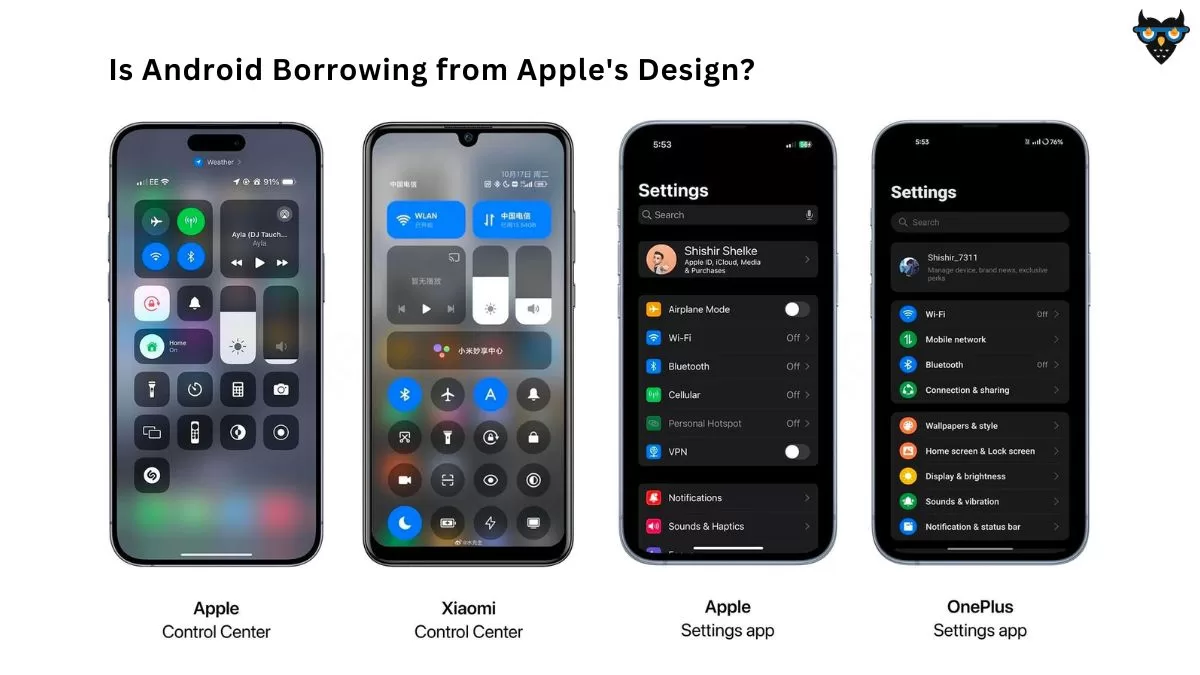Is Android Borrowing from Apple’s UI Design? A Closer Look at UI Trends

In the world of mobile technology, user interface design plays a pivotal role in shaping the user experience. With the evolution of operating systems like Android and iOS, it’s not uncommon to notice resemblances in design elements. In this discussion, we’ll delve into the similarities between Android and Apple’s UI designs, particularly focusing on the Control Center and Settings app, and consider whether Android should aim for more distinct UI designs.
The Resemblance:
Recently, keen-eyed smartphone users have observed that some Android manufacturers seem to be taking design cues from Apple‘s iOS 17. Let’s examine two notable examples:
Xiaomi’s Control Center:
Xiaomi’s MIUI is known for its versatility and personalization options. However, it’s hard to overlook the striking resemblance between Xiaomi’s Control Center and Apple’s Control Center. With a swipe-down gesture, users can access quick settings and notifications. The design is reminiscent of iOS, and the recent introduction of widgets brings even more parallels to the iOS 17 experience.
OnePlus’ Settings App:
OnePlus, a prominent Android device manufacturer, has opted for a design language in its Settings app that echoes Apple’s iOS 17. From the icons to the menu layouts, OnePlus has seemingly drawn inspiration from Apple’s design philosophy.
The Big Question: Should Android Strive for Uniqueness?
The Android ecosystem is celebrated for its diversity and adaptability. This has allowed manufacturers to develop their own user interfaces, offering users a wide range of choices. However, as Android evolves, it raises the question of whether the platform should strive for more distinctive UI designs.
While Apple’s iOS is known for its clean and straightforward UI, this has attracted admirers who appreciate its user-friendliness. For Android, it has meant accommodating a wide array of UI designs and experiences, which can sometimes lead to fragmentation and inconsistency.
The resemblance between Xiaomi’s Control Center, OnePlus’ Settings app, and iOS 17 is evidence of the appeal of Apple’s design philosophy. But it also highlights the ongoing debate about whether Android, as a whole, should aim for a more unified and unique user interface.
In reality, Android has made substantial progress in refining its UI over the years. Many Android manufacturers, including Xiaomi and OnePlus, have made efforts to improve their designs while maintaining their unique identities. Users have the flexibility to choose an Android experience that aligns with their preferences, whether it’s close to stock Android or a more customized interface.
In conclusion, while it’s intriguing to observe the similarities and inspirations in UI designs, Android’s diversity remains one of its defining features. As long as Android manufacturers continue to prioritize usability and user experience, the ecosystem will continue to offer a wide range of choices, ensuring that there’s an Android experience for every taste. The ongoing debate about Android’s UI design is a testament to the platform’s adaptability and the ever-evolving nature of mobile technology.
Frequently Asked Questions (FAQs):
Frequently Asked Questions (FAQs):
Q1: Is Android copying Apple’s design?
Android’s diversity allows manufacturers to develop their UI, which sometimes resembles Apple’s design philosophy. However, this isn’t uniform across all Android devices.
Q2: Are similarities in UI design a problem?
Similarities can be influenced by a focus on usability and a desire to provide familiar, user-friendly experiences. It’s not inherently a problem, but it does spark discussions about design originality.
Q3: Can Android users choose their UI design?
Yes, Android’s strength lies in its flexibility. Users have the freedom to choose a device and UI design that aligns with their preferences, whether it resembles stock Android or is customized by the manufacturer.
Q4: What should Android prioritize in UI design?
Android should prioritize a balance between user-friendliness and unique identity. Usability and a positive user experience should be central to any UI design.
Q5: Is this debate unique to mobile technology?
No, design inspiration and similarities are common in various industries, reflecting the ongoing evolution of user interface design. The debate mirrors discussions about design influences in the broader design world.
Also Read: Motorola’s Vision for a Wearable Smartphone: Unveiling the Future of Mobile Technology
Also Read: Exploring iOS 17.1 New Features and How to Make the Most of Them